Why Is a Shingling Hammer Ideal for Roofing Work?
People often ask, ‘Why is a shingling hammer ideal for roofing work?‘ Roofing tasks demand precision, durability, and efficiency, making the right tools essential for success. One key tool for these tasks is the shingling hammer, a specialized hammer designed specifically for roofing applications. Its unique features and design make it an invaluable asset for both professional roofers and DIY enthusiasts.
Providing both speed and accuracy, the shingling hammer is engineered to simplify the installation of shingles. This guide delves into what makes the shingling hammer ideal for roofing work, including its key features, how to choose the right one, and tips for proper use and maintenance. This comprehensive understanding will help you make the most of this essential tool in your roofing projects.
What Is a Shingling Hammer?
Definition and Features
A shingling hammer, also known as a roofing hammer, is a versatile tool specifically designed for roofing tasks. It combines essential features that enhance both functionality and efficiency. The built-in claw allows for easy removal of old or damaged shingles, while the flat striking face is made for driving nails into shingles with precision. This dual functionality makes it an indispensable tool for professional roofers and DIY enthusiasts alike.
Key Features of Shingling Hammers
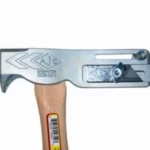
Shingle Spacing Gauge:
- Helps measure shingle spacing accurately.
- Ensures uniform installation, which is essential for both aesthetics and performance.
Tailored Design:
- Specifically designed to meet the demands of roofing work, unlike traditional hammers.
Dual Functionality:
- Not only drives nails but also claws off tiles, shakes, and cut shingles.
Integrated Gauges:
- Assist roofers in determining the correct exposure for shingles.
- Promotes a consistent and professional finish.
Magnetized Faces:
- Many models feature magnetized faces to pick up stray nails.
- Reduces the risk of accidents and helps maintain a cleaner work area.
Design Specifications of Shingling Hammers
Shingling hammers are both lightweight and durable, usually constructed from steel or fiberglass. They are meticulously balanced to minimize fatigue during extended periods of roofing work. Additionally, the ergonomic handle offers a comfortable grip, enhancing safety and efficiency, especially when working on steep roofs.
Lightweight and Durable Construction:
- Typically made from materials like steel or fiberglass, they can withstand demanding roofing tasks while remaining easy to handle.
Balanced Design:
- Meticulously balanced to minimize fatigue during long hours of use, which is crucial for maintaining productivity and comfort.
Ergonomic Handle:
- Designed for a comfortable grip, enhancing safety and efficiency, especially when working on steep roofs.
Distinctive Roofing Hatchet Style:
- Recognizable for its axe-like appearance, contributing to its functionality and ease of use.
Sharp Knife Edge:
- Allows for easy cutting of shingles, making it efficient for trimming and fitting shingles around obstacles.
Integrated Nail Puller:
- Streamlines the process of removing old or misplaced nails, further enhancing its utility.
Magnetic Nail Holder:
- Facilitates easy and accurate nail placement, reducing the risk of dropping nails during installation.
Common Roofing Hammers
Modern and traditional roofing hammers come in various designs, each featuring unique attributes and advantages tailored to specific roofing tasks.
Shingling Hammer

Arguably the most recognizable type of roofing hammer, the shingling hammer—often called a roofing hatchet—features an axe-like appearance. This versatile tool is primarily used for installing asphalt shingles and includes a sharp knife edge for cutting, nail pullers for removing old nails, and a magnetic holder for easy nail placement. With its multi-functional design, the shingling hammer offers both versatility and efficiency, making it an essential tool for any roofer.
Double-Claw Hammer
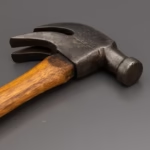
For a wide range of general roofing tasks, the double-claw hammer is a versatile tool. Its dual claws make it ideal for pulling out nails and effectively prying wood and other materials. If the hammer has a straight claw, it can also be used for light-cutting applications. The double-claw hammer’s adaptability makes it a valuable addition to any roofer’s toolkit, capable of handling various tasks with ease.
Roofing Pick Hammer
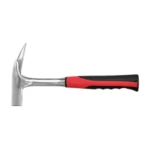
Characterized by a sharpened, pointed pick on one end, the roofing pick hammer is particularly useful for specific roofing tasks. Its primary function is to punch holes in roofing materials, although it can also be used to pull out nails. This feature is especially beneficial for creating starter holes for nails, ensuring a secure installation. The roofing pick hammer is a specialized tool that enhances efficiency in roofing projects by simplifying the process of preparing materials.
Slate Hammer
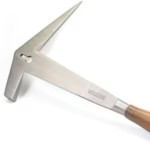
The slate hammer is specifically designed for working with slate roofing materials. It typically features a sharpened pick for punching holes, a beveled shaft for cutting slate, and a nail puller for removing old fasteners. While the slate hammer excels in general slate work, it may not be the best choice for extensive slate installation or repair. Its specialized design makes it an invaluable tool for roofers who work primarily with slate, allowing for precise and effective handling of this unique material.
Benefits of Using a Shingling Hammer
Efficiency in Nail Driving
The shingling hammer’s flat striking face and balanced weight are specifically designed to streamline the process of driving nails. Minimizing the time spent on each installation, this feature allows roofers to drive nails quickly and effortlessly. The hammer’s design reduces the amount of force required, making it easier to achieve consistent results without excessive effort.
Efficiency in nail driving is crucial in roofing work. Accurate and uniform nail placement plays a significant role in the overall durability and integrity of the roof. Properly driven nails ensure that shingles are securely attached, helping to prevent issues such as water infiltration and wind damage. Additionally, consistent nail placement contributes to a more aesthetically pleasing finish by ensuring that shingles lay flat and align correctly.
Versatility in Functionality
What makes the shingling hammer ideal for roofing work is its dual functionality. While it is primarily used for driving nails into shingles, the built-in claw allows for easy removal of damaged or old shingles, significantly saving time and effort during repairs or replacements.
The claw enables roofers to address issues without needing additional tools, facilitating nail removal with an effective grip that minimizes the risk of damaging surrounding materials. This allows roofers to efficiently transition between tasks, making the shingling hammer an essential tool in their toolkit. Overall, its versatility enhances productivity on the job site.
Improved Safety Features
The shingling hammer features several safety enhancements that make it reliable for roofing work. Its ergonomic design ensures a comfortable fit, reducing fatigue and allowing for better control. The non-slip grip prevents accidental slips, especially in wet or uneven conditions.
The hammer’s balanced weight distribution minimizes strain on the wrist and arm, promoting steady handling and accurate nail driving. Together, these safety features create a safer working environment, enabling roofers to focus on their tasks with confidence.
Choosing the Right Shingling Hammer
Shock Absorption Capability
One of the main features to consider in a roofing hammer is its ability to absorb shock. Roofing tasks often require hours of continuous hammering, which can lead to fatigue and potential injury if the tool doesn’t effectively dampen vibrations. Opt for a hammer equipped with built-in shock absorption technology to protect your hands and minimize fatigue during long work sessions.
Handle Material Selection
The material of the hammer’s handle significantly impacts its performance and comfort. Steel offers exceptional durability and strength but tends to lack effective shock absorption. In contrast, wood provides excellent shock absorption and comfort, although it may not be as durable as steel. Fiberglass is lightweight and comfortable but generally offers less durability than both steel and wood.
Weight Considerations
Roofing hammers typically weigh between 20 and 30 ounces. A hammer that is too heavy can lead to quick fatigue, while one that is too light may not deliver sufficient force for driving nails effectively. It’s advisable to test different weights by swinging the hammer to determine which feels comfortable and well-balanced for your needs.
Proper Use and Techniques
Best Practices for Using a Shingling Hammer
Maintain a Firm Grip and Proper Posture
Hold the hammer with a firm grip to ensure control and precision. Maintain proper posture by standing with feet shoulder-width apart, bending your knees slightly, and keeping your back straight. This stance enhances stability and allows for better leverage when swinging the hammer.
Use Controlled, Steady Strikes
Aim for controlled, steady strikes when driving nails. Consistent, measured blows promote accuracy and ensure nails are driven flush with the shingles. This technique reduces the risk of damaging the shingles and leads to a more professional finish.
Leverage the Claw for Shingle Removal
Utilize the claw to remove old or damaged shingles effectively. Position the claw under the shingle and apply gentle pressure to lift it, minimizing damage to the roof beneath. When removing nails, grip the nail head with the claw and leverage it out smoothly to avoid bending or damaging the roofing materials.
Common Mistakes to Avoid
Avoid Overstriking
A frequent mistake when using a shingling hammer is overstriking, which can damage shingles and compromise their integrity. It can also lead to nails being driven too deep, reducing their effectiveness. Focus on delivering controlled strikes with sufficient force to avoid this issue.
Don’t Use Excessive Force When Removing Shingles
Using excessive force to remove shingles can result in injuries and damage to the underlying roofing materials. Instead, gently lift shingles and nails using the claw of the hammer. This method minimizes the risk of injury and protects the roof, making the removal process safer and more efficient.
Maintenance and Care
Keeping Your Shingling Hammer in Top Condition
- Regular Cleaning:
-
- Frequently clean your shingling hammer to remove debris, dirt, and asphalt residue. This prevents buildup that can lead to rust and deterioration over time.
- Inspect for Damage:
- Regularly check the hammer for any signs of damage, such as cracks in the handle or wear on the claw. Addressing these issues early can prevent further damage and ensure safety during use.
-
Replace Parts as Needed:
- If you notice any damaged components, such as a worn claw or a cracked handle, replace them promptly. Keeping your tool in optimal condition enhances its performance and longevity.
Storage Recommendations
- Use a Dry Toolbox:
- Always store your shingling hammer in a dry toolbox to prevent moisture accumulation. Humidity can lead to rust and deterioration of the tool, so a moisture-free environment is essential.
- Organize Your Toolbox:
- Keep your toolbox organized by designating a specific space for your shingling hammer. This prevents it from being jostled around with other tools, reducing the risk of damage.
- Avoid Contact with Other Tools:
- Store the hammer in a manner that minimizes contact with other tools or sharp objects. This helps prevent scratches, dents, or other damage that could affect its performance.
- Utilize Protective Cases:
- Consider using protective cases or pouches designed for hammers. These can provide an extra layer of protection against impacts and environmental factors.
- Check Storage Conditions:
- Regularly check the storage area for signs of moisture or damage. Ensure that the toolbox remains dry and that the hammer is stored properly after each use.
- Accessibility:
- Store the hammer in an easily accessible location within your toolbox. This ensures that it is ready for use when you need it for your next roofing project, saving time and effort.
Conclusion
The shingling hammer is an essential tool for roofing work, combining precision, durability, and efficiency to meet the demands of both professionals and DIY enthusiasts. Its unique features, such as a built-in claw and ergonomic design, enhance functionality while promoting safety and comfort during use. By understanding its key attributes, choosing the right hammer, and following best practices for use and maintenance, you can maximize the effectiveness of this invaluable tool in your roofing projects. Proper care and storage will ensure that your shingling hammer remains in top condition, ready to tackle any job with confidence.
FAQs
- Why is a shingling hammer ideal for roofing work?
It combines precision, versatility, and safety features for efficient roofing tasks. - What is a shingling hammer used for?
It’s used to drive nails, remove shingles, and measure shingle spacing during roofing work. - How is a shingling hammer different from a regular hammer?
It has a built-in claw and gauges for roofing-specific tasks, unlike traditional hammers. - What materials are shingling hammers made from?
Common materials include steel and fiberglass, offering durability and lightweight options. - What is the average weight of a shingling hammer?
Shingling hammers typically weigh between 16 and 22 ounces for balanced performance. - Can I use a shingling hammer for other construction tasks?
Yes, but it’s optimized for roofing tasks and may not be ideal for general construction. - How do I maintain a shingling hammer?
Clean it regularly, check for wear, and store it in a dry, safe place. - What brands offer the best shingling hammers?
Estwing, Vaughan, and Stanley are popular choices among roofers. - Is a fiberglass or steel hammer better for roofing work?
Fiberglass is lightweight, while steel offers more durability; choose based on your needs. - What makes a shingling hammer ergonomic?
Features like a non-slip grip and balanced weight distribution enhance comfort and safety.
For more articles about DIY, click the link below
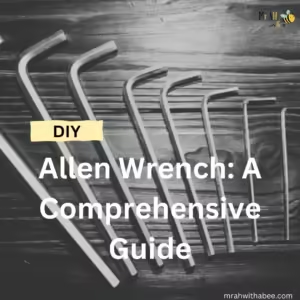
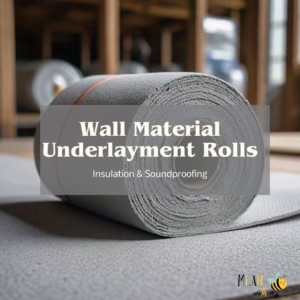
For more interesting articles, visit our homepage.

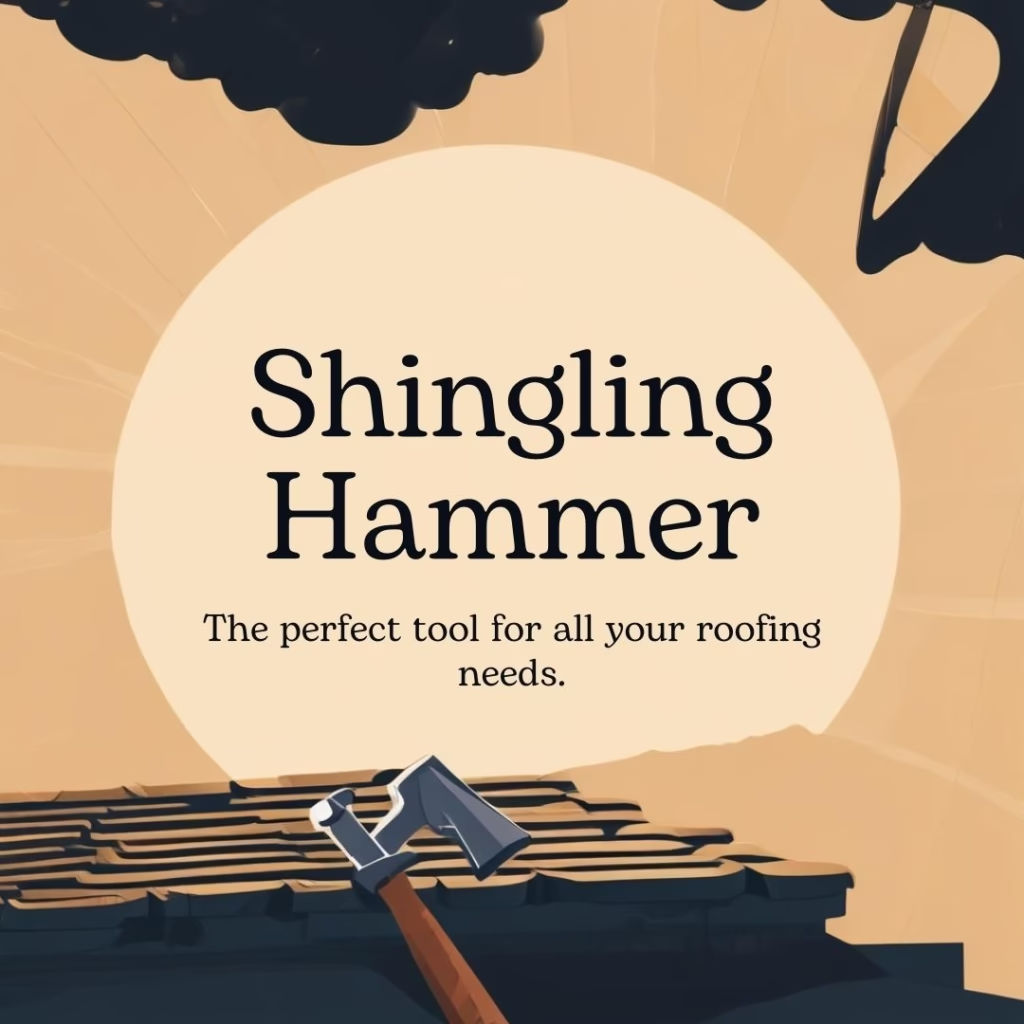
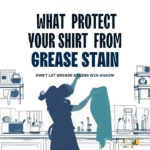

Pingback: What Is a Clutch Drive Tool: Applications and Tips